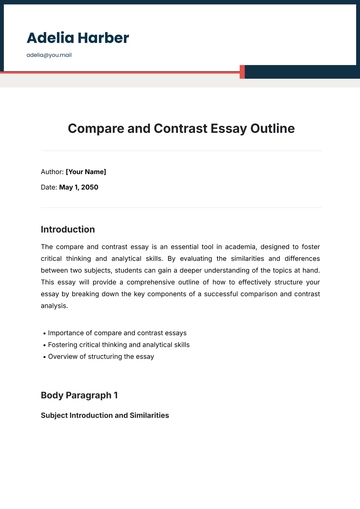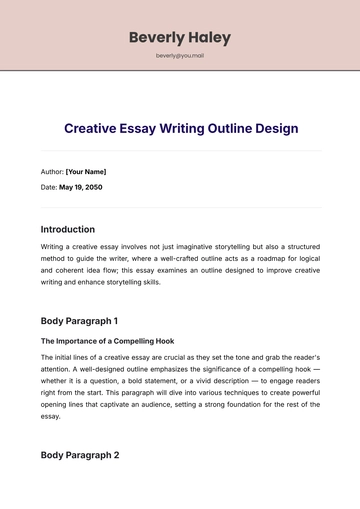Free Academic Curriculum Essay

Written By: [Your Name]
The Evolving Academic Curriculum: Balancing Tradition and Innovation
Introduction
The academic curriculum is the cornerstone of educational systems worldwide. It serves as the blueprint that outlines the knowledge, skills, and competencies that students are expected to acquire at various stages of their education. As societies evolve, so too must the curriculum, balancing traditional educational values with the demands of a rapidly changing world. This essay explores the critical components of an academic curriculum, the factors influencing its development, and the ongoing debate between maintaining tradition and embracing innovation.
1. Foundations of the Academic Curriculum
The academic curriculum is traditionally rooted in a set of core subjects such as mathematics, science, language arts, and social studies. These subjects form the foundation of a well-rounded education, ensuring that students develop essential literacy and numeracy skills, critical thinking abilities, and a basic understanding of the world around them. Historically, this approach has aimed to create informed citizens capable of contributing to society. However, the static nature of this curriculum model often struggles to adapt to the evolving needs of students in the 21st century.
2. The Role of Cultural and Societal Influences
Cultural and societal factors play a significant role in shaping the academic curriculum. In diverse societies, there is a growing need for curricula that reflect multicultural perspectives and inclusivity. Additionally, societal changes such as technological advancements, globalization, and shifts in the job market necessitate updates to the curriculum. For example, the rise of digital technology has led to the inclusion of computer science and digital literacy as essential components of modern education. These changes illustrate how societal needs drive curriculum development, ensuring that education remains relevant and responsive to the demands of the time.
3. The Integration of Technology in Education
The integration of technology into the academic curriculum represents one of the most significant shifts in education over the past few decades. Digital tools and resources have transformed how subjects are taught and learned, enabling personalized learning experiences, increasing access to information, and fostering collaboration beyond the classroom. For instance, the use of educational software, online courses, and virtual simulations has expanded the horizons of traditional teaching methods. However, this integration also poses challenges, such as the digital divide and the need for teachers to acquire new skills, which must be addressed to ensure equitable access to quality education.
4. Balancing Tradition with Innovation
One of the central debates in curriculum development is how to balance traditional educational values with the need for innovation. While core subjects and classical education principles remain vital, there is a growing recognition that students also need to develop skills for the future, such as creativity, problem-solving, and adaptability. This has led to the introduction of interdisciplinary studies, project-based learning, and STEM (Science, Technology, Engineering, and Mathematics) education. The challenge lies in integrating these innovative approaches without compromising the depth and rigor of traditional academic disciplines.
5. The Future of the Academic Curriculum
Looking ahead, the academic curriculum is likely to continue evolving in response to emerging trends and challenges. Climate change, artificial intelligence, and global health issues are just a few of the topics that are beginning to shape educational priorities. Future curricula will need to prepare students not only with knowledge but with the ethical frameworks and critical thinking skills necessary to navigate complex global issues. Moreover, lifelong learning is becoming increasingly important, suggesting that the curriculum of the future will extend beyond the traditional K-12 model to encompass continuous education throughout a person’s life.
Conclusion
The academic curriculum is at a crossroads, challenged by the need to preserve the valuable aspects of traditional education while adapting to the demands of a rapidly changing world. By acknowledging the influence of cultural and societal factors, embracing technological advancements, and striking a balance between tradition and innovation, educators can design curricula that are both relevant and rigorous. As the world continues to evolve, so too must the academic curriculum, ensuring that it remains a dynamic and responsive tool for preparing future generations.
- 100% Customizable, free editor
- Access 1 Million+ Templates, photo’s & graphics
- Download or share as a template
- Click and replace photos, graphics, text, backgrounds
- Resize, crop, AI write & more
- Access advanced editor
Craft essays that align with your curriculum using Template.net’s Academic Curriculum Essay Template. This customizable and editable template provides a structured approach to writing essays that meet academic standards. Editable in our AI Editor Tool, it’s perfect for students at any level. Tailor the template to your specific curriculum requirements and produce well-organized, thoughtful essays.





























